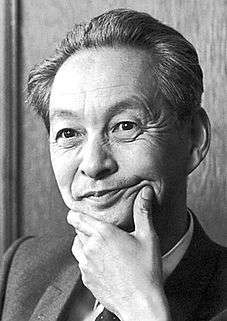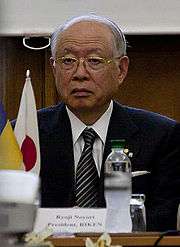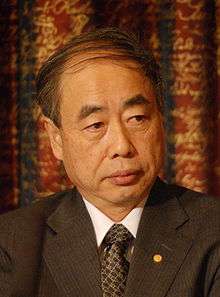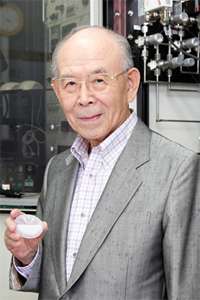List of Nobel laureates affiliated with Kyoto University
Ten Nobel laureates have been affiliated with Kyoto University. The building pictured is Clocktower.
The Nobel Prizes are awarded annually by the Royal Swedish Academy of Sciences, the Karolinska Institute, and the Norwegian Nobel Committee to individuals who make outstanding contributions in the fields of chemistry, physics, literature, peace, and physiology or medicine.[1] As of October 2014, 10 then-current faculty and research staff at Kyoto University were Nobel laureates. There were not including the Third High School (precursor of Kyoto University) graduate Leo Esaki.
Laureates
| Year | Image | Laureate | Relation | Category | Rationale |
|---|---|---|---|---|---|
| 1949 |  |
Hideki Yukawa | Alumnus; member of the faculty | Physics | "for his prediction of the existence of mesons on the basis of theoretical work on nuclear forces".[2] |
| 1965 |  |
Sin-Itiro Tomonaga (shared with Julian Schwinger and Richard Feynman) |
Alumnus | Physics | "for their fundamental work in quantum electrodynamics, with deep-ploughing consequences for the physics of elementary particles".[3] |
| 1981 | Kenichi Fukui (shared with Roald Hoffmann) |
Alumnus; D.Eng; member of the faculty | Chemistry | "for their theories, developed independently, concerning the course of chemical reactions".[4] | |
| 1987 | .jpg) |
Susumu Tonegawa | Alumnus | Physiology or Medicine | "for his discovery of the genetic principle for generation of antibody diversity."[5] |
| 1991 |  |
Aung San Suu Kyi | Visiting fellow (1985-1986); honorary fellow | Peace | "for her non-violent struggle for democracy and human rights". |
| 2001 |  |
Ryōji Noyori (shared with William Knowles and Barry Sharpless) |
Alumnus; D.Eng | Chemistry | "for their work on chirally catalysed hydrogenation reactions".[6] |
| 2008 |  |
Makoto Kobayashi (shared with Yoichiro Nambu and Toshihide Maskawa) |
Member of the faculty (1972-1979) | Physics | "for the discovery of the origin of the broken symmetry which predicts the existence of at least three families of quarks in nature".[7] |
 |
Toshihide Maskawa (shared with Yoichiro Nambu and Toshihide Maskawa) |
Member of the faculty (1980-2003); honorary professor | Physics | "for the discovery of the origin of the broken symmetry which predicts the existence of at least three families of quarks in nature".[7] | |
| 2012 |  |
Shinya Yamanaka (shared with John B. Gurdon) |
Member of the faculty | Physiology or Medicine | "for the discovery that mature cells can be reprogrammed to become pluripotent".[8] |
| 2014 |  |
Isamu Akasaki (shared with Hiroshi Amano and Shuji Nakamura) |
Alumnus | Physics | "for the invention of efficient blue light-emitting diodes which has enabled bright and energy-saving white light sources".[9] |
See also
References
- ↑ "Alfred Nobel – The Man Behind the Nobel Prize". Nobel Foundation. Retrieved 2008-10-18.
- ↑ "The Nobel Prize in Physics 1949". Nobel Foundation. Retrieved 19 December 2009.
- ↑ "The Nobel Prize in Physics 1965". Nobel Foundation. Retrieved 19 December 2009.
- ↑ "The Nobel Prize in Chemistry 1981". Nobel Foundation. Retrieved 19 December 2009.
- ↑ "The Nobel Prize in Physiology or Medicine 1987". Nobel Foundation. Retrieved 19 December 2009.
- ↑ "The Nobel Prize in Chemistry 2001". Nobel Foundation. Retrieved 19 December 2009.
- 1 2 "The Nobel Prize in Physics 2008". Nobel Foundation. Retrieved 19 December 2009.
- ↑ "The Nobel Prize in Physiology or Medicine 2012". Nobel Foundation. Retrieved 24 August 2015.
- ↑ "The Nobel Prize in Physics 2014". Nobel Foundation. Retrieved 24 August 2015.
External links
- Official website of Princeton University
- Official website of the Royal Swedish Academy of Sciences
- Official website of the Nobel Foundation
This article is issued from Wikipedia - version of the 10/27/2016. The text is available under the Creative Commons Attribution/Share Alike but additional terms may apply for the media files.